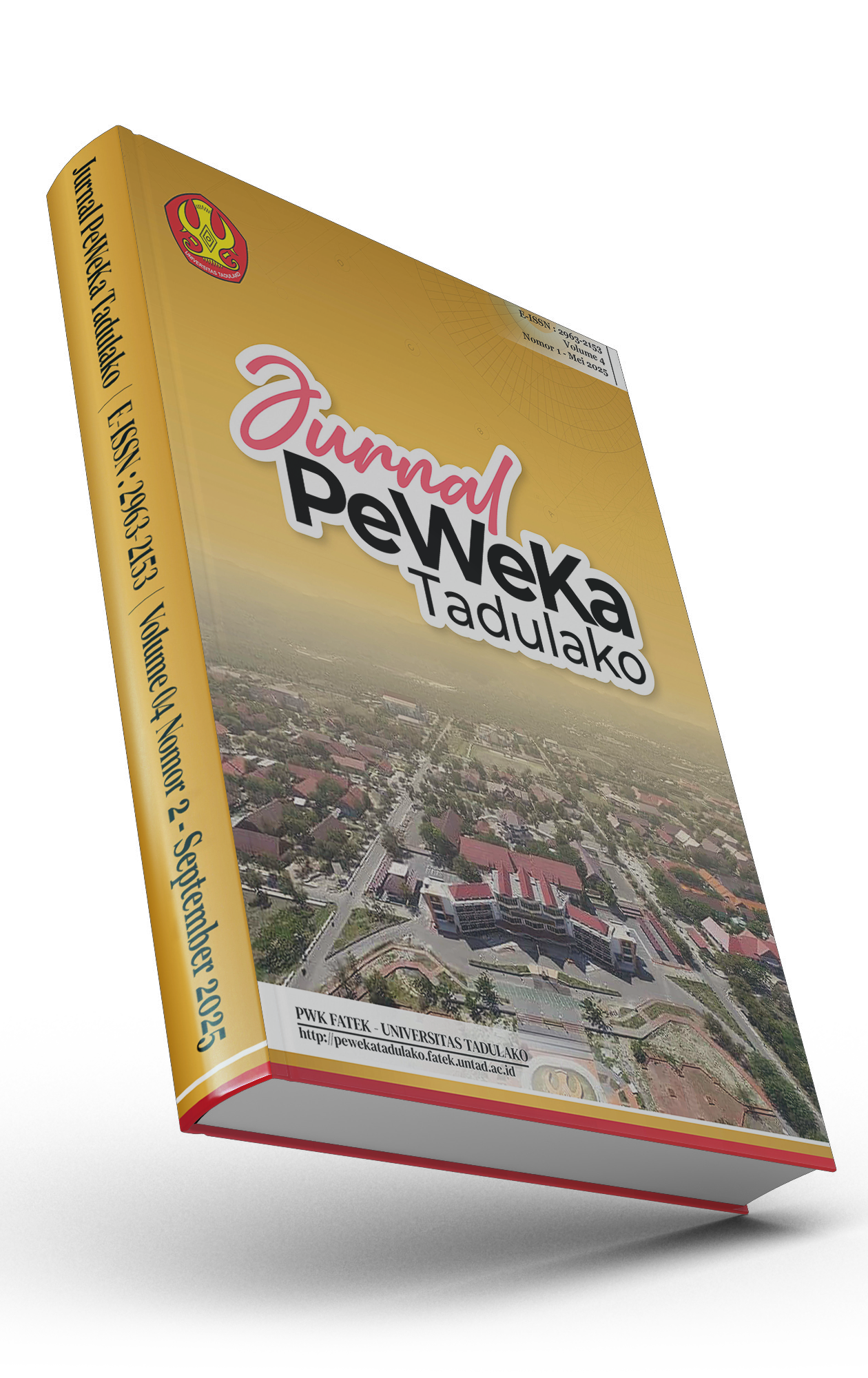Koherensi Kebijakan dan Perencanaan Kota Berkelanjutan: Studi Kasus RDTR Kota Palu
DOI:
https://doi.org/10.22487/peweka.v4i2.79Keywords:
Detailed Spatial Plan, Policy Coherence, Sustainable Development, Palu CityAbstract
Sustainable urban development requires alignment between national policies, local spatial planning, and commitments to global agendas. Palu City, as a growth center in Central Sulawesi and an area with high disaster vulnerability, needs a Detailed Spatial Plan (RDTR) that not only regulates land use but also integrates principles of sustainability and disaster resilience. This study aims to assess the extent to which Palu City’s RDTR aligns with Law No. 11 of 2020 on Job Creation, Government Regulation No. 21 of 2021 on Spatial Planning Implementation, and Sustainable Development Goal (SDG) 11. This research employed a document-based literature review, analyzing relevant regulations, the RDTR document, and academic literature. The evaluation was conducted using a policy coherence framework to examine internal, vertical, and horizontal consistency. The findings reveal that Palu City’s RDTR demonstrates strong internal consistency, with clear integration between objectives, strategies, and regulatory instruments. Vertically, it aligns with the national legal framework, particularly in zoning, protection of conservation areas, and land-use control. Horizontally, it contributes to several SDG 11 targets, including safe and affordable transportation access, disaster risk reduction, and the provision of green public spaces. However, disaster mitigation integration lacks measurable indicators, cross-sectoral synergy remains limited, and public participation needs to be extended to the implementation stage. Strengthening multi-hazard risk mapping, adopting inclusive cross-sectoral strategies, and establishing sustainable public participation mechanisms are recommended to make Palu City’s RDTR more adaptive, responsive, and aligned with sustainable development principles.
References
Budiati, L., & Rukmana, D. (2019). Tata Ruang Kota dan Wilayah. Jakarta: Kencana.
Firman, T., & Hudalah, D. (2018). Peri-urbanisation in East Asia: A New Challenge for Planning? International Development Planning Review, 40(1), 27–45. https://doi.org/10.3828/idpr.2018.2.
Kusno, A. (2019). Architectural and Political Change in Jakarta: Imagining The City. Singapore: NUS Press.
Nugroho, S. P., & Wibowo, A. (2020). Implementasi RDTR dalam pengendalian pemanfaatan ruang perkotaan. Jurnal Tata Kota dan Daerah, 12(2), 85–97. https://doi.org/10.xxxx/jtkd.v12i2.XXXX.
Pemerintah Republik Indonesia. (2020). Undang-Undang Nomor 11 Tahun 2020 tentang Cipta Kerja. Lembaran Negara Republik Indonesia Tahun 2020 Nomor 245.
Pemerintah Republik Indonesia. (2021). Peraturan Pemerintah Nomor 21 Tahun 2021 tentang Penyelenggaraan Penataan Ruang. Lembaran Negara Republik Indonesia Tahun 2021 Nomor 32.
Rustiadi, E., Saefulhakim, S., & Panuju, D. R. (2018). Perencanaan dan Pengembangan Wilayah (Edisi Revisi). Jakarta: Yayasan Pustaka Obor Indonesia.
Santoso, J., & Widodo, J. (2021). Urban governance and sustainable development in Indonesia. Habitat International, 108, 102301. https://doi.org/10.1016/j.habitatint.2020.102301.
Setiawan, B., & Firman, T. (2017). Challenges in implementing spatial planning in Indonesia. Planning Practice & Research, 32(2), 200–218. https://doi.org/10.1080/02697459.2017.1299405.
Surya, B., Saleh, H., & Abubakar, H. (2020). Spatial transformation of the urban fringe and impacts on sustainable urban development. Sustainability, 12(16), 6511. https://doi.org/10.3390/su12166511.
United Nations. (2015). Transforming our world: The 2030 Agenda for Sustainable Development. United Nations. https://sdgs.un.org/goals/goal11.
Widianingsih, I., & Pranoto, Y. (2022). Kebijakan publik dan tata ruang kota berkelanjutan: Studi kasus RDTR perkotaan. Jurnal Perencanaan Wilayah, 18(1), 45–58. https://doi.org/10.xxxx/jpw.v18i1.XXXX
World Bank. (2021). Indonesia Sustainable Cities Program: Enhancing Urban Resilience. World Bank Group. https://documents.worldbank.org.
Yuniarto, P., & Purnomo, E. (2016). Koherensi kebijakan tata ruang dalam pembangunan berkelanjutan. Jurnal Administrasi Publik, 13(2), 155–169.
Zamzami, L., & Putra, D. (2023). Evaluasi kesesuaian RDTR dengan tujuan pembangunan berkelanjutan di kota menengah Indonesia. Journal of Regional and City Planning, 34(1), 23–38. https://doi.org/10.xxxx/jrcp.v34i1.XXXX.
Downloads
Published
How to Cite
Issue
Section
License
Copyright (c) 2025 Sitti Rabiatul Wahdaniyah Herman, Supriadi Takwim, Rasdiana A, Adina Khusnudzan Hadid, Muhammad Adhim Halim

This work is licensed under a Creative Commons Attribution-ShareAlike 4.0 International License.







